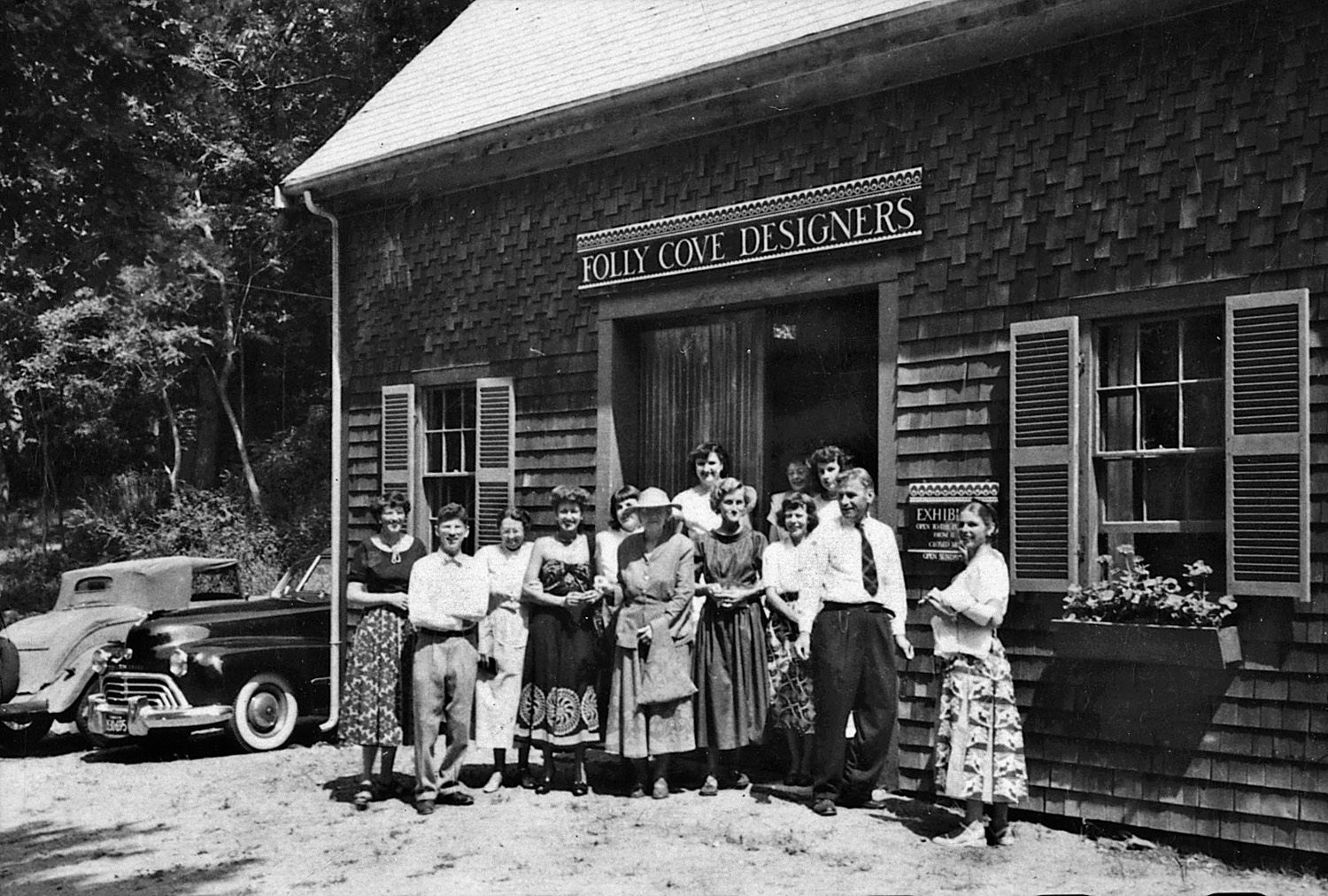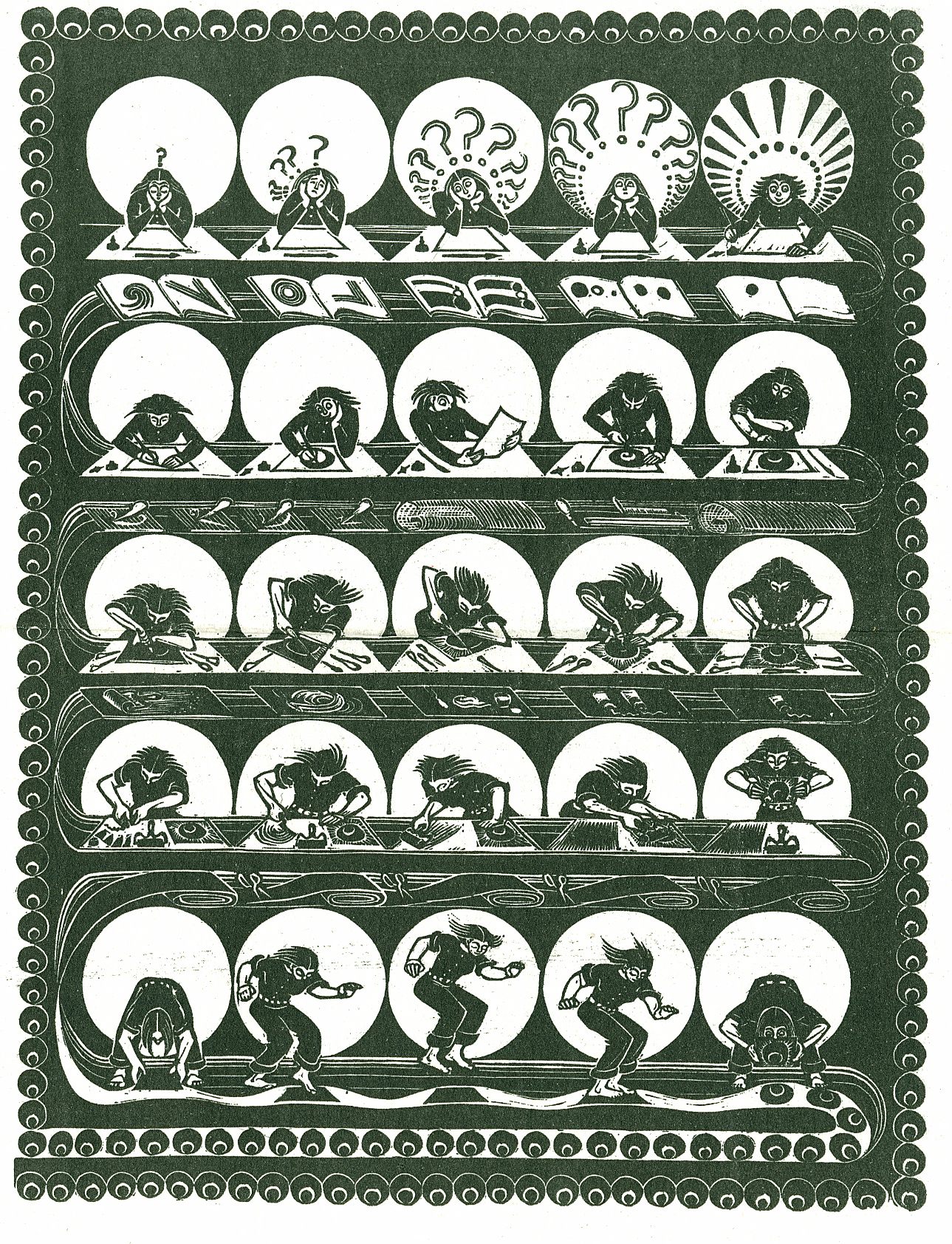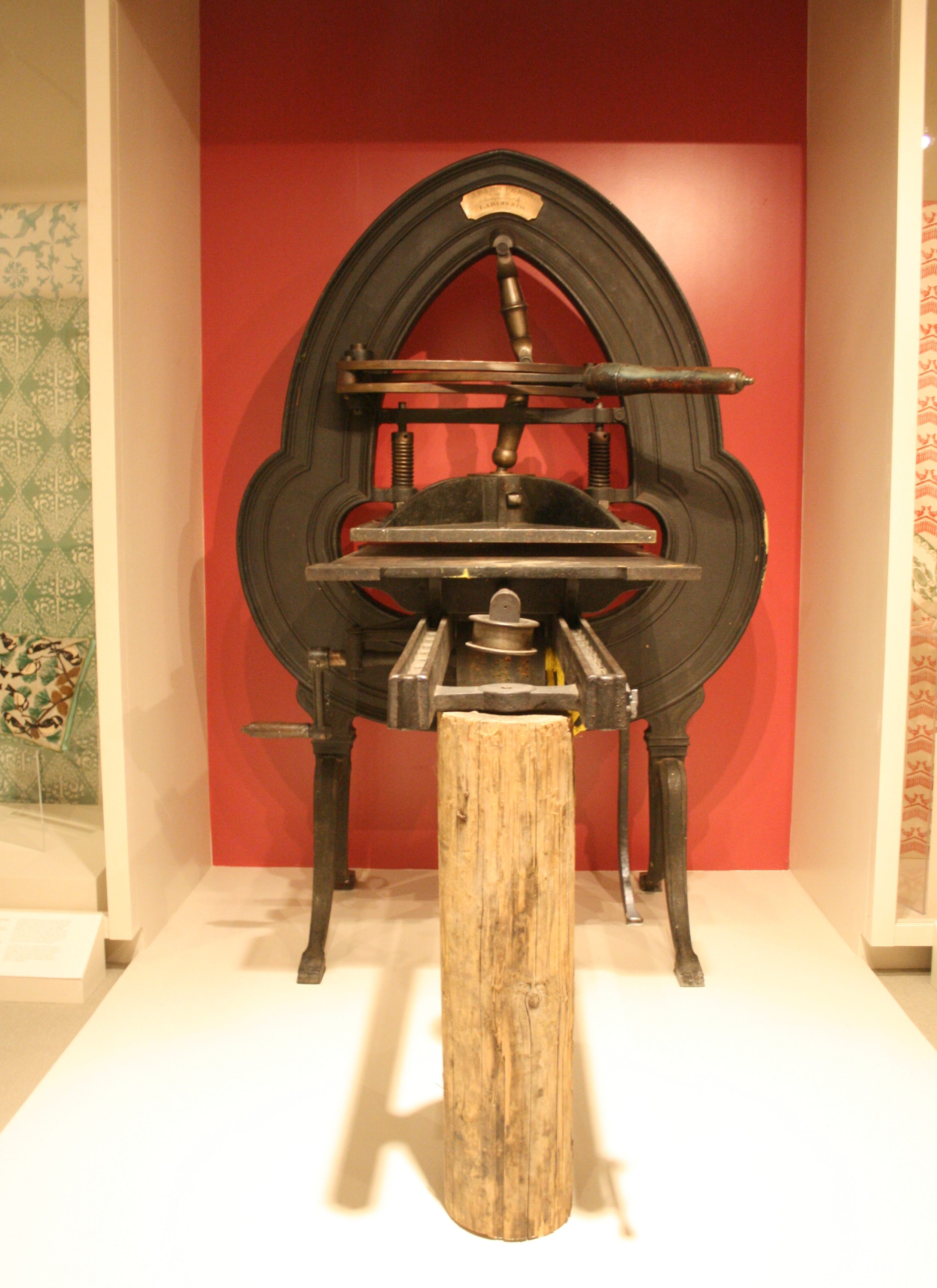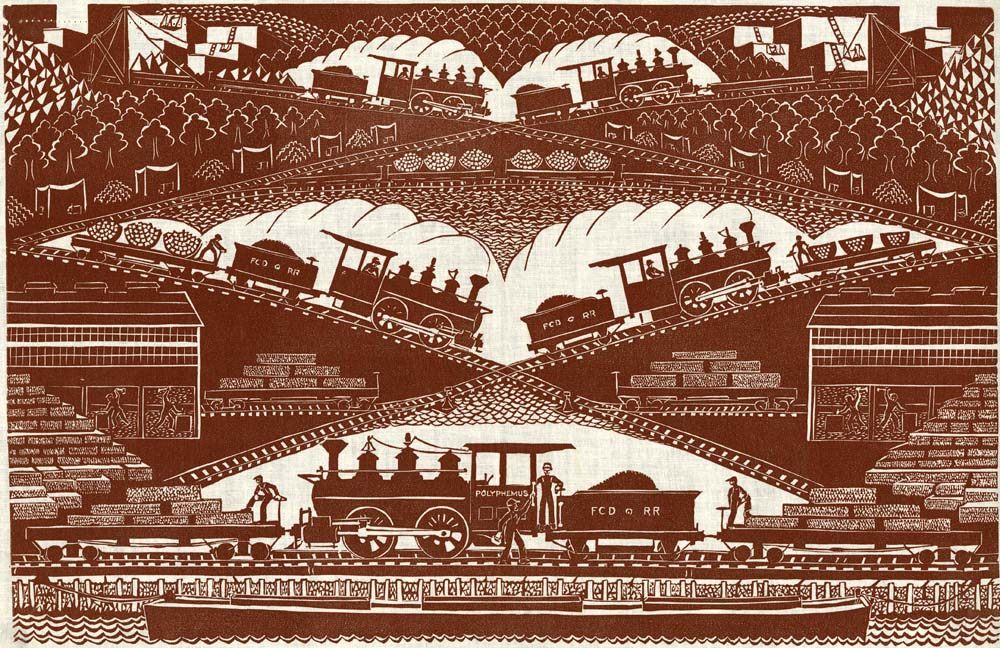The Unlikely Story of the Folly Cove Guild, the Best Designers You’ve Never Heard Of
Led by beloved children’s author Virginia Lee Burton, this group of mostly untrained women created immortal designs.
One by one, the prints unfold before you. One shows sheep leaping in the grass, another, children on a tree-hung swing, the moon shifting above them. All are charming, sophisticated, and unbelievably detailed. They take the essence of everyday objects and activities, and unspool them into mesmerizing patterns. No matter how much you may want them, though, you can’t get these prints on Etsy. In fact, you can’t get them anywhere.
They live mere miles from where they were produced, at the Cape Ann Museum in Gloucester—the last bastion of the nearly forgotten Folly Cove Designers. Helmed by a children’s book illustrator and comprised of her previously untrained friends and neighbors, the Folly Cove Designers were hardworking, tight-knit, and sincere—so sincere, they eventually voted themselves into obscurity.
To children worldwide, Virginia Lee Burton is the beloved hand behind half a dozen classics, including Mike Mulligan and His Steam Shovel, Katy and the Big Snow, and The Little House, intricately illustrated tales of close-knit communities. But to her neighbors at Folly Cove, on the north shore of Massachusetts, she was Jinnee Demetrios. Jinnee and her husband, the sculptor George Demetrios, moved to the area in 1932 with their one-year-old son Aristides, who was soon followed by Mike. The couple quickly became community pillars, making art all day, and spending evenings gathering their friends and neighbors for raucous sheep roasts.

“Folly Cove gets its name because it would be folly to bring a ship in and turn it around,” says Christine Lundberg, producer of the film Virginia Lee Burton: A Sense of Place, as well as the upcoming Beautiful and Useful: The Art of the Folly Cove Designers. This ethos carried over into the rough-and-ready town life. “You couldn’t get pretty little things,” says Lundberg. “If you wanted them, you had to make them.” An artist through and through, Jinnee surrounded herself with homemade treasures, including, as the story goes, a particularly nice set of block-printed curtains. One of her neighbors, Aino Clarke, admired the curtains so much she wanted to make her own. Jinnee and Aino struck a deal: Jinnee would give Aino top-to-bottom design lessons if Aino, a member of the local orchestra, would teach Jinnee’s sons the violin. (A less legendary, but perhaps more truthful, version of this tale holds that Aino suggested Jinnee give design lessons to her neighbors in exchange for money to buy the necessary paper to illustrate her first book.)
Regardless of exactly how the two came together, Jinnee’s flint struck on Aino’s iron sparked an artistic movement. Within its rock-hard exterior, Folly Cove harbored a vein of artistic impulse that dated all the way back to the 1800s, when painters had flocked there to take advantage of the seashore’s distinct sunlight. (“If you spend time lying on the granite around here, you get creative powers,” one resident told Lundberg). As Jinnee and Aino dove into the lessons, other members of the community began joining them.

Thus began the Folly Cove Designers (FCD), a ragtag group of locals united by their desire to fill their lives and their minds with a particular form of well-thought-out beauty. Many members were, like Aino Clarke, the children of Finnish immigrants, and sought to combat the economic and emotional hardships of the Great Depression. Others were so-called “Yankees,” who had moved permanently to Folly Cove after vacationing there as children, and who wanted something new to do. Eino Natti, one of the group’s few male members, was an Army veteran and former quarryman—experiences he drew on for prints such as Polyphemus, of a granite-carting train, and PT, which shows near-identical soldiers in mid-squat. Elizabeth Holloran, the local children’s librarian, printed young people skiing and sugaring. “A majority of them were never artists,” says Cara White, director of the Cape Ann Museum’s Folly Cove gallery. “They were editors, architects, housewives, accountants.”
This didn’t matter to Jinnee, who was convinced that—through practice—anyone could learn design. To enable this, Jinnee put her students through a rigorous artistic process that cycled with the seasons. In the fall, members met in the Folly Cove Barn for class, learning Jinnee’s guiding design principles and choosing subjects for their prints. Jinnee steered her students away from lofty or imagined subjects, and encouraged them to find inspiration in everyday Cape Ann life.
The resulting familiarity and love, she believed, would come out in the design. Jinnee herself printed everything from commuter trains to spring lambs to her fellow guild members, gossiping over mailboxes cheekily labeled “VLB,” “AC,” and “FCD.” When it came time to ink these designs, she often chose the greens and browns of an omnipresent local plant—seaweed.

During this time, members also did what Jinnee called “homework”—painstaking, repetitive drawing exercises, meant to help the artists get to know their subjects inside and out. “If a student wanted to feature an apple in her design, she had to fully explore the fruit: the whole apple, its sections, the seeds, the blossom,” writes Jennifer Scanlon, a professor of Gender, Sexuality, and Women’s Studies at Bowdoin College and the author of an article drawn from ethnographies of the group’s members. “Through this examination, and the resulting series of drawings, the apple became hers.”
Over the autumn of 1958, for example, veteran guild member Peggy Norton did at least 300 sketches for what would become Story and a Half House, a study of her own home in Gloucester. The drawings, all in stark black and white, show the house from every angle, repeated in a multiplicity of patterns—large and small, straight and spiraling, tiled, mirrored, and jauntily diagonal. The final print, a kaleidoscope of large and small houses, is the clear result of all these permutations, greater than the sum of its parts.

At the beginning of winter, members gathered in the barn once again, this time to jury their final designs before a small, rotating group of their peers. Approved drawings would be redrawn on linoleum blocks and painstakingly carved, a process that took anywhere from 60 to 100 hours. Members toted their blocks around like extra children, making time for them in between other responsibilities. Some worked at their kitchen counters, and later joked of finding linoleum hunks in the mashed potatoes. By spring, when the blocks were done, it was back to the barn to ink the linoleum, lay out their chosen fabric, and make the prints, which they did in their typical bootstrapped fashion: by jumping up and down on the block.
In 1940, the designers added a summer element to the cycle—they festooned the barn with their newly printed cocktail napkins, nightgowns, placemats, and swimwear, and opened it to the public for an informal exhibition. It paid off: “People were just all over what they were doing,” says White. Within a few years, they were putting on an annual show, plying attendees with coffee and Finnish nissu bread and selling their wares to tourists and townies alike.

Those who made it far enough to publicly display a design had also “passed” the class. These new FCD members received a diploma, designed and hand-printed by Jinnee herself. Rather than Latin or cursive, this certificate got across the recipient’s accomplishments via a 25-panel cartoon that detailed the entire printmaking process, from the initial brainstorming to the final jump.
As the guild grew, Jinnee kept steering it with an iron fist. “She was a woman driven,” says White, before doubling down—“No, she was a woman obsessed.” In a typical day, she might wake at 5 a.m., work until her sons clamored for breakfast, head out for a quick swim, and then duck back into her studio, where she focused so diligently on illustrations, prints, and other work that, according to her eldest son, she “nearly drove herself blind.” Outside said studio, she hung a hand-painted sign featuring a cartoon self-portrait that stuck out her tongue and waggled her fingers at the viewer. “Working 5 AM to 5 PM,” it said. “If you have nothing to do, don’t do it here!”

She expected similar commitment from her students. Each guild member was required to produce at least one block per year, which they shepherded from a seed of an idea all the way to a fully blossomed print. Everyone, even longtime veterans, had to take Jinnee’s class every year to remain in the group, redoing the homework and relearning the design principles until they were carved into their collective consciousness like, well, designs in a block. Though some members only stayed for one cycle, many stuck it out year after year, and begrudged this repetition only slightly. As one member put it, “We find new secrets in the darned thing every time.”
In the early 1940s, the group voted in a business manager, member Dorothy Norton. She collected dues from each member and used the money to buy the guild consistent supplies—good ink, precise carving tools, and acre upon acre of battleship linoleum, decommissioned by the U.S. government after it proved too flammable for use in Navy boats. Eventually, members began acquiring professional-grade acorn presses, which, though less dynamic than the tried-and-true jumping technique, managed a steadier print. Spring evenings would see members criss-crossing Cape Ann, schlepping their blocks and fabrics to the nearest press.

Throughout the ’40s, ’50s, and ’60s, a bigger audience found the FCD. Lord & Taylor dedicated 20 showrooms to the group’s designs, and they were showcased in museums from the Metropolitan to the Smithsonian. As the spotlight intensified, the guild steadfastly refused to compromise. When a Macy’s representative told Jinnee that if she played her cards right, she’d soon be able to drive a Rolls Royce, she was said to have replied, “I like my Ford.”
Further temptations followed, but the group stuck fast to their principles. After a wholesale company ripped off one of their designs, they began patenting them, locking the originals in a safety deposit box. A porcelain company asked to print Eino Natti’s Roosters on a set of dishware, but it proved too detailed for their machines. Rather than simplify the design, the guild cancelled the contract.
The money that did come in propelled the group forward—some members made a living off of it. But in the mid-’60s, Jinnee, an avid smoker, developed lung cancer. As she sickened, guild members helped her continue working; Natti even cranked the press for her, an act previously forbidden under the group’s DIY ethos. But when she passed away, in 1968, they voted to disband. Over the course of the next year, they sold the barn and gave their inventory to the Cape Ann Historical Society, now the Cape Ann Museum. The members, and all the businesses they had worked with, agreed never again to reproduce any of the group’s prints.

In Mike Mulligan and His Steam Shovel, perhaps Jinnee’s most famous work, Mike and his machine, Mary Ann, volunteer to dig the foundation for a new town hall. After finishing the job in a single day, they find themselves stuck down there, unable to get out. Rather than scrapping the steam shovel or undoing her work, the community decides to transform her into the town hall’s furnace, and Mike into the building’s janitor. They figure her indomitable spirit will warm the town for decades to come.
In this way, Jinnee’s dedication warmed the community she formed, even after her death. “She wanted people to have art in their daily lives, and she believed that people get something fundamental out of hard work,” says Scanlon. “It became an important component of who they were, and how they participated in the world—and, probably most importantly, how they saw themselves in their everyday lives. As community members, as housewives, but also as people who produced something beautiful.”
This story originally ran on August 21, 2016.

























Follow us on Twitter to get the latest on the world's hidden wonders.
Like us on Facebook to get the latest on the world's hidden wonders.
Follow us on Twitter Like us on Facebook